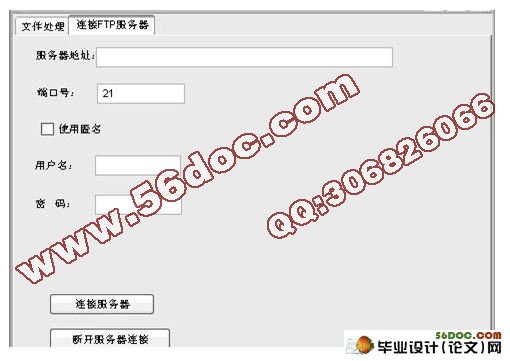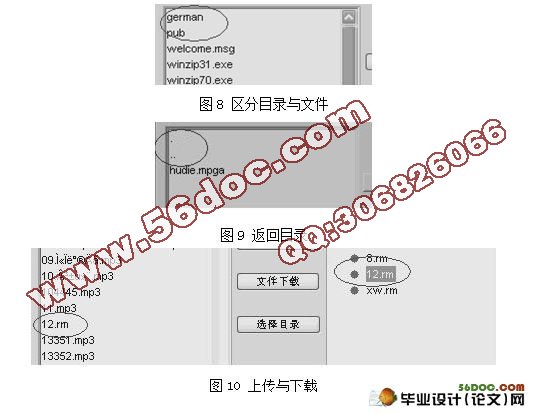FTP客户端软件的设计
无需注册登录,支付后按照提示操作即可获取该资料.
FTP客户端软件的设计(选题审批表,任务书,开题报告,中期检查表,毕业论文8600字)
摘 要:FTP 是File Transfer Protocol(文件传输协议)的英文简称,而中文简称为“文传协议”。用于Internet上的控制文件的双向传输。同时,它也是一个应用程序(Application)。用户可以通过它把自己的PC机与世界各地所有运行FTP协议的服务器相连,访问服务器上的大量程序和信息。FTP的主要作用,就是让用户连接上一个远程计算机(这些计算机上运行着FTP服务器程序)察看远程计算机有哪些文件,然后把文件从远程计算机上拷到本地计算机,或把本地计算机的文件送到远程计算机去。为了用户更方便的使用FTP服务,提供更好的人机交互界面,本文将使用JAVA以及JBuilder的ftpclient库,基于Client/Server的架构方式,编写一个友善界面的FTP客户端工具,实现服务器连接、远程与本地目录浏览、文件上传和下载等基本FTP工具常用功能。
关键词:文件传输协议;FTP客户端;上传;下载
The Design and Implementation of FTP Client
Author:ChenXun
Tutor:WuLin
(Oriental Science &Technology College of Hunan Agricultural University, Changsha 410128)
Abstract:FTP Protocol (File is' File Transfer Protocol) English abbreviation, while Chinese referred to as the "WenChuan agreement". Used to control the files on the Internet two-way transmission. Meanwhile, it is also an Application (apply). Users can through which the own PC with the world all run FTP protocol servers connected, access server amounts of procedures and information. The main effect, it is FTP let users connect to a remote computer (these computers to run on the FTP server program) examine the remote computer what files, and then put the documents from the remote computer kao to local computer, or local computer files to the remote computer. The use of user for more convenient FTP, providing better man-machine interface, the subject will use JAVA and the JBuilder ftpclient library, based on the architecture are/Server mode, write a friendly interface FTP Client tools, realize the Server connection, remote and local directory browsing, file upload and download such basic FTP tool common functions. Key words: File transfer protocol; FTP client; Upload; download


目 录
1 引言 1
1.1选题背景 1
1.2 选题目的 1
2 相关基础技术与开发平台 1
2.1 JAVA技术 1
2.1.1 JAVA简介 1
2.1.2 C/S架构简介 2
2.2 FTP基础 3
2.3 开发平台 4
3系统需求分析与总体设计 4
3.1 需求分析 4
3.2 设计思路 5
3.3实现思路 5
4 系统模块的实现 7
4.1 界面模块实现 7
4.2 登录模块实现 8
4.3 浏览程序 10
4.3.1浏览服务器端目录程序 10
4.3.2本地浏览程序 12
4.4文件下载和上传程序 13
4.4.1文件下载程序 13
4.4.2文件上传程序 13
5 系统测试及问题处理 15
5.1测试环境 15
5.2 测试结果 15
5.2.1登录模块测试 15
5.2.2系统兼容性测试 16
5.3 测试总结 16
结 论 17
参考文献 18
致 谢 19
